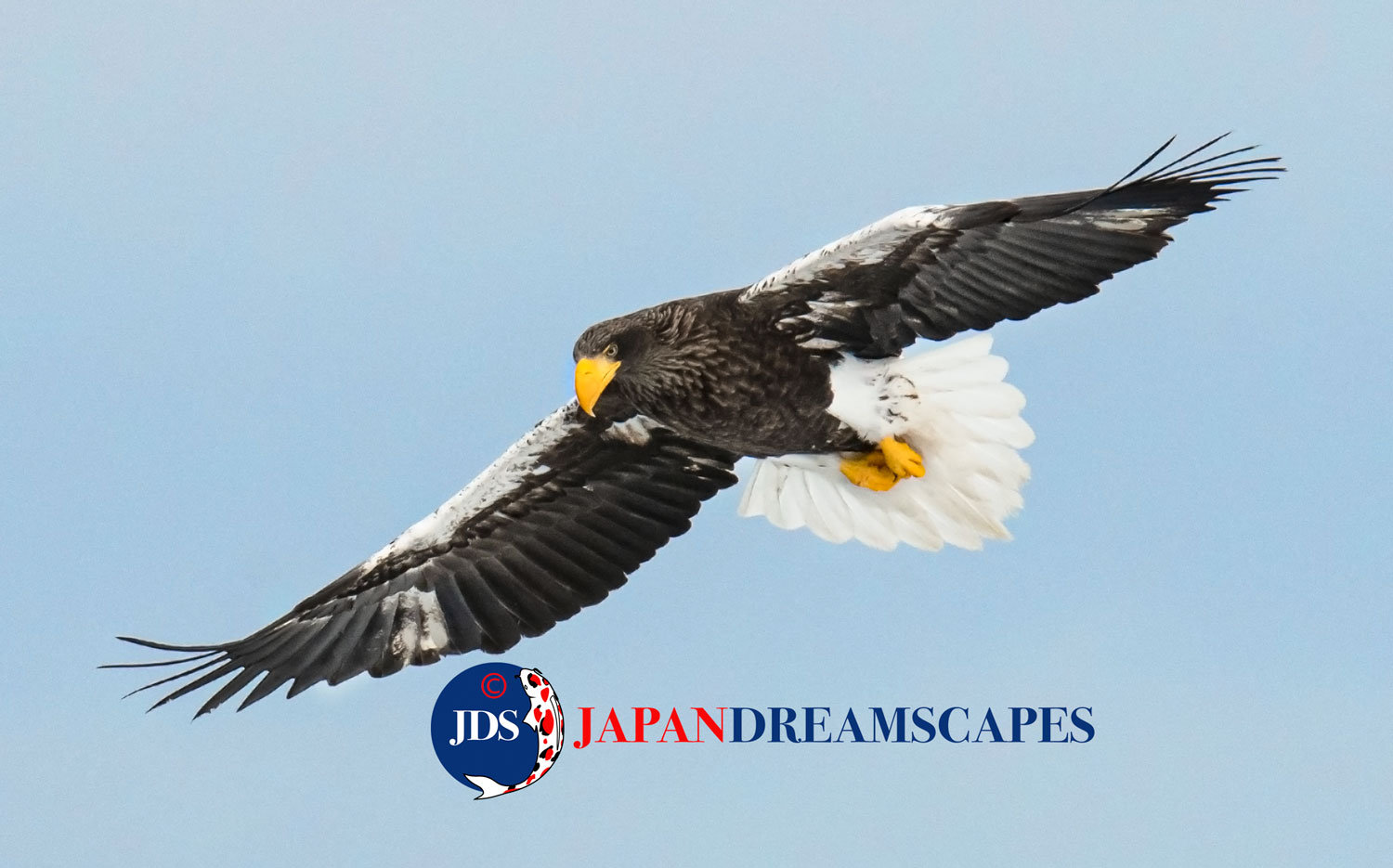Our photo workshop leaders always look forward to leading the annual JDS Hokkaido photography tour. The main JDS Hokkaido tour includes Mt. Fuji, a samurai castle, and snow monkeys. In fact, it has become in such high demand that we needed to create a second tour just for the wildlife and landscape photographers; this new tour focuses exclusively on Hokkaido. We are 100% okay with spending more of the winter in Hokkaido leading Japan birding workshops. Plus, we spot and photograph dozens of species of wildlife and minimalist landscapes.
The main event for birding photographers in Hokkaido is always a coin toss between the Red-crowned cranes (Grus japonensis) and the world famous raptor of prey, the Steller’s Sea Eagle (Haliaeetus pelagicus). Ninety nine percent of the time, you will never see these two birds flying next to one another, but from time to time a stray Steller’s sea eagle does wander into the cranes’ territory, but this is rare. Photographing these two species is an entirely different photography experience. Visiting and photographing the Red-crowned cranes is as relaxing as meditation and has the feel of a natural Zen experience, such as Shinrin Yoku, Japanese forest bathing. These cranes are natural entertainers, and they aren’t known as snow ballerinas of Hokkaido for nothing. These huge birds’ courtship dance is legendary, as they are as graceful as British Royal Ballet Dancers. The Steller’s Sea Eagles is an exciting bird to photograph, that keeps photographers on edge and on their toes; it takes dedication to get those gallery worthy shots. By mass, the Steller’s sea eagle is the largest eagle on our planet, and their attitude matches. These birds of prey have the largest bill out of all raptors which is razor sharp; they devour whole fish minutes, and their talons are huge and as sharp as their bills; they are so sharp that our workshop leaders have never seen a Steller’s sea eagle slip on the shiny slick pack ice. The Steller’s Sea Eagles use the pack ice as their home and fishing platform for most of the winter.
Part of what makes the Steller’s Sea Eagle such a sought after photographic subject is their growing rarity. The Steller’s Sea Eagle have been put on the International Union for Conservation of Nature’s (IUCN's) list as vulnerable because of their decrease in numbers, just over 4,000 specimens in the wild. During early spring to late autumn they occupy a small section of Russian claimed Kuril Islands that extend off of the Kamchatka Peninsula. The eagles’ domain extends down into portions of Hokkaido that are part of my annual winter birding expedition, and as our JDS photography workshop leaders know the best locations in Hokkaido that the eagles call home, no matter how scarce the number, we guarantee clients over a 90% chance that you will spot and photograph these raptors. Another feature that makes Steller’s Sea Eagles such a magnificent subject are their natural gifts. The eagles stand between three and three and half feet tall (91 - 107 cm), one of the largest raptors in the world. However, what makes them a photographic spectacle is their ferocity and the contrast of their nearly all black body against the shining white pack ice. Our Japan photo workshop leaders have visited Hokkaido for more than two and a half decades, and they have to confess that every year when they see the first Steller’s Sea Eagle spread its wings wide as it soars the winds along the Hokkaido coastline, they take just a moment to appreciate the majesty and nobility of the perfect raptor predator. The Steller’s Sea Eagles is perpetually hunting, and it’s always only a matter of time before prey becomes its sole focus as it swoops into the pack ice in pursuit of one of its favorite winter meals, fish of any kind. Considering the median wingspan of The Steller’s Sea Eagle is over 2 meters (approximately 7 feet), while on your Japan Photo Tour, you’ll be able to spot and photograph the eagles with fully extended wings. Our Hokkaido photography workshop specialist has personally recorded instances of wingspans up to 2.5 meters, nearly 8 feet and wider!




0 Comments